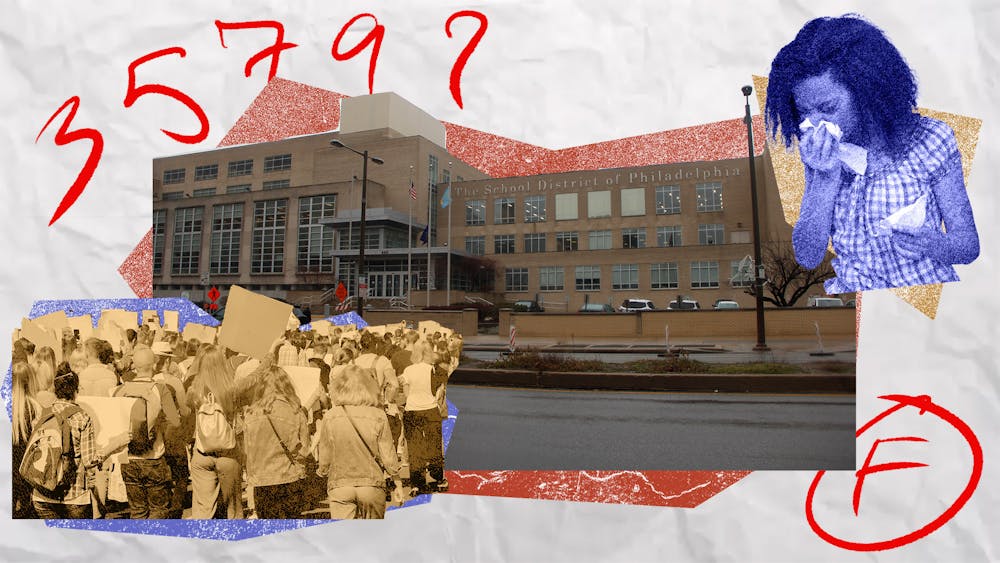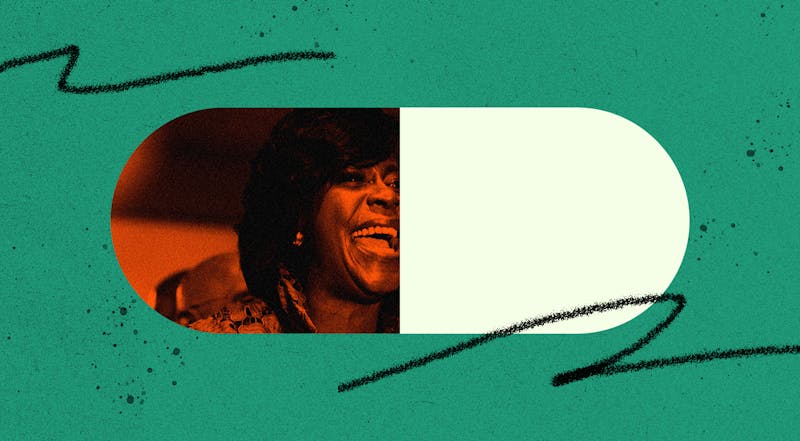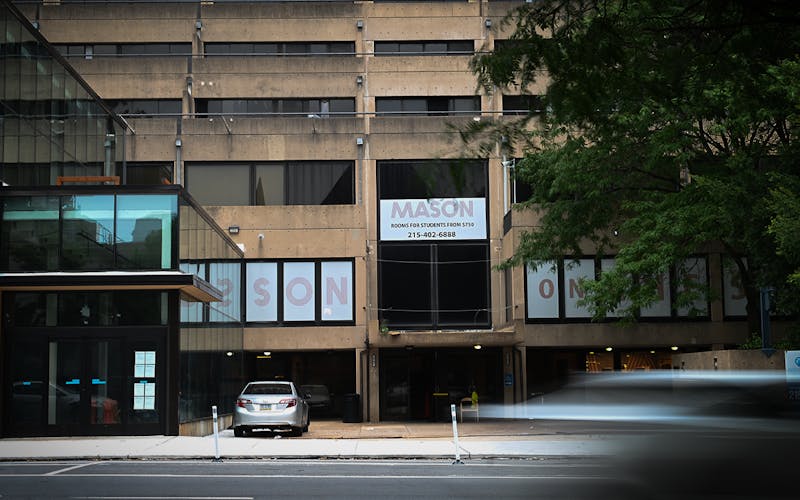Post–pandemic, hand sanitizer has emerged as a sacred commodity while every ill–concealed cough is met with glaring suspicion. As students across campus gulp down packets of Emergen–C and shovel cough drops down their throats, their frantic efforts to dodge an invisible enemy are eclipsed by the inevitability of illness.
In the face of sickness, many students are inclined to spontaneously begin a ritualistic diet of Campbell’s chicken soup in lieu of attending classes. While sick days have become a naturalized entity in students’ minds, teachers are not afforded the same luxury of taking time off to attend to their personal health.
Although Philadelphia educators are contractually granted ten sick days a year, they are paradoxically penalized for their sanctioned absences. Under the state’s “3–5–7–9” policy, teachers are forced to have a conference with the principal after their third absence—regardless of whether the absence is taken non–consecutively or consecutively. Following their fifth absence, teachers have an informal warning memo added to their permanent file, and, after their seventh absence, the informal warning is increased to an “unsatisfactory event” memo in their file in addition to a required disciplinary conference. A teacher’s ninth absence culminates in a second unsatisfactory incident report, a recommended suspension, and further disciplinary conferences with upper administration.
The policy can be traced back to a case from 40 years ago that saw a district secretary terminated on the grounds of “poor attendance.” Although the Philadelphia Federation of Teachers sought to appeal the verdict, their attempts failed under the arbitrator’s assertion that “management can require reasonably steady attendance as a condition of employment, regardless of the reasons for the absences, since otherwise the employee is of no practical value to the enterprise.” As a result, the state can circumvent teachers’ right to take their contractually allotted sick days to exert progressive discipline against their “absences.”
Even though the policy has been in practice for over a decade, the city’s school district has recently found itself under fire for the mandate’s threat to teachers’ welfare. As educators are forced to weigh whether their own health is worth bearing the state’s disciplinary retribution, they have begun to demand an end to the antiquated mandate.
On May 23, teachers from across the district gathered to protest against the state’s “3–5–7–9” policy outside the School District of Philadelphia’s headquarters. Congregating in a circle, educators brandished picket signs denouncing the mandate and belted a litany of chants expressing their frustration with the district’s stance.
The demonstration was organized by the Caucus of Working Educators, which drew together two dozen teachers from across the city to criticize the district’s apathetic response to past complaints about the policy. Peter Doherty, a fifth–grade English and language arts teacher at John Welsh School, helped encourage other teachers throughout the district to attend the protest through social events, telephone campaigns, and inter–communal outreach initiatives.
Throughout the protest, teachers shared insight into how the policy has impaired their quality of life. For educators with chronic illnesses, the district fails to account for the unpredictable and unavoidable nature of long–term health conditions, forcing teachers to decide between protecting their health or their job security.
Similarly, the mandate places an undue burden on educators caring for young children who are prone to frequent bouts of illness. Often, teachers must use their own sick days to care for their children, making it that much more difficult to adhere to the policy’s restrictive limits. Thus, teachers with children find themselves situated in a stressful dilemma as they attempt to avoid professional repercussions while still attending to their children’s health needs.
“[The policy] has affected me personally when I’ve had to take sick days, and I’ve gotten memos,” Doherty says. “This year, there have been days where I’ve had to care for my children, and there was no one else to. I can’t leave a five year old at home, and I can’t send him to school when he’s sick.”
Prior to his tenure at John Welsh School, Doherty worked for the New York City Department of Education and other schools on the East Coast. When he first joined the School District of Philadelphia two years ago, he was shocked by the city’s use of an “escalating punitive policy” that undermined teachers’ legal rights. Currently, Philadelphia’s school district is the only major urban school district on the East Coast that has continued to use the “3–5–7–9” policy, leading Doherty to wonder: “Why are we trying to be unique in penalizing teachers?”
Philadelphia educators’ recent protest builds upon past efforts to push the school district towards amending the policy. Back in February, the PFT presented the school board with a petition signed by 2,000 members that demanded a revision to the mandate. However, a spokesperson for the board claimed that “the issue is not something the board can take action on for now because it’s a district policy.”
In turn, although School District of Philadelphia Superintendent Tony Watlington has publicly expressed that he is open to revising the mandate, he has failed to take any definitive action toward implementing an updated version of the policy. On the contrary, Watlington’s Deputy Chief of Communications Monique Braxton wrote in a statement to Street that “discipline of a teacher for poor attendance, including suspension or termination, is extremely rare.” According to Braxton, rather than endanger teacher welfare, the policy is considered an incentive to promote teacher attendance, one of the focus points for the district’s desired areas for improvement.
“The goal of these conversations is to encourage attendance and provide support when needed, similar to encouragement and support we provide to students about their attendance,” Braxton said in a public statement. “We offer many days of paid time off per year, and no teacher should come to work when they are sick.”
Despite the superintendent’s claim that a correlation exists between improved teacher attendance and the policy’s enforcement, many teachers believe that the mandate has the opposite effect.
“Let’s say I take one sick day,” Doherty says. “The next day I’m feeling better and can come back to work, but then my child unexpectedly gets sick. If I decide to take another day, that would count as two occurrences, whereas if I had just taken three days in a row, that would still count as one occurrence, and I’m not moving up the ladder of punishment.” According to the mandate’s guidelines, a single sick day will be considered an occurrence. While sick days are individual days taken off due to illness, occurrences are a three–day period that can be used for other types of absences. “It creates this idea in the district where if you’re going to take one sick day, you might as well take a couple because that way you can use your sick days while avoiding further penalty.”
By encouraging educators to extend their leave so as to not feel the policy’s punitive wrath, district officials are adversely harming students by subjecting them to a subpar education. Because many students are dependent on the continuity provided by sustained interaction with their instructors, substitute teachers are unable to offer the same level of support as an educator who is acquainted with their specific academic needs. Gaps in student–teacher interaction can lead to decreased student engagement and lower academic performance.
“Students only thrive when they have their regular teacher in a safe and stable environment,” Doherty says. “[Teachers] need to take a day off, just as we would want a student who’s genuinely sick to take time to recuperate and get better.”
Beyond its detrimental impact on student and teacher welfare, the policy simultaneously fuels national trends in teacher shortages. A recent analysis by Penn State University found that teacher attrition in the district has steadily increased since 2018, with 23% of charter teachers and 13% of district teachers leaving their roles in 2022. Researchers concluded that “[t]he number of teachers leaving the profession in Philadelphia County exceeds the number of newly prepared teachers by local teacher preparation programs.”
As a result, the district has become increasingly reliant on hiring teachers outside the state or those who lack the requisite credentials. Rising trends in teacher attrition across the state raise the question: What role does “3–5–7–9” play in spurring teachers’ decision to leave the profession?
By penalizing teachers for taking sick days, the district’s policy dismisses legitimate health issues and familial obligations of educators. Chronic illnesses and personal health emergencies are common realities that teachers are not immune to. By reforming the “3–5–7–9” mandate, the district has the opportunity to begin crafting a more equitable educational system, starting with granting teachers the sick leave that they deserve.






